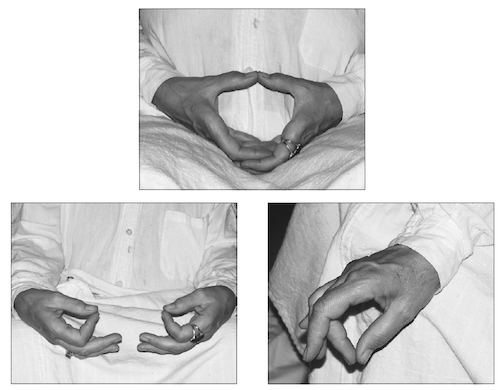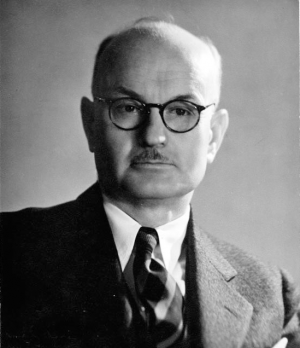EDWARD CHACE TOLMAN:
THE THINKING MAN’S RAT, or GETTING TO KNOW YOU, SAYS THE RAT TO THE SITUATION
AN INTRODUCTION TO “PURPOSIVE BEHAVIORISM
I. BIOGRAPHY
Tolman was the third child and second son of an upper-class new England family. His father, the head of a Massachusetts manufacturing company, had been in the first graduating class at MIT. A staunch believer in the puritan ethic of hard work and constant effort, one of his favorite mottos was “tend to business.” The father hoped his sons Richard and Edward would follow him into the family business. Encouraged by his wife, who had been raised a Quaker, he was also interested in social reform. Tolman/s mother was a warm and caring person who tried to instill in her children her Quaker values of plain living and high thinking.
Both sons were good at mathematics and both studied experimental and theoretical chemistry at M.I.T.. Richard avoided going into business by getting a Ph.D. and becoming a distinguished physicist. His career culminated in his work as an associate of Robert Oppenheimer on the atomic bomb project at Los Alamos. Edward later said he had gone to M.I.T. due to family pressure rather than because he wanted to. He read William James and transferred to Harvard. He studied philosophy and psychology and then spent a summer in Germany with the Gestalt psychologist Kurt Koffka.
At Harvard the laboratory specialized in nonsense syllable learning under Hugo Munsterberg. Munsterberg’s laboratory meetings at which students presented and discussed their research opened with a brief lecture which described introspection as the method of psychology; then the students and research assistants would present studies in which introspection was seldom used.
To Tolman, something did not seem quite right, especially since his fellow graduate students showed no inclination to transfer to Cornell where they could be instructed by the master of introspection, Titchener himself. His dissertation (Ph.D. 1915) was a study of retroactive inhibition. But Tolman preferred the course in comparative psychology taught by Robert Yerkes, in which Watson/s book: Behavior: An Introduction to Comparative Psychology was the text. This text dismissed the obligation to use introspection, and Tolman reflected that his memory drum experiments did not depend on introspection.
He started teaching at Northwestern in 1915. With war fervor mounting, he wrote an pacifist essay which resulted in his dismissal in 1918. But U.C. Berkeley offered him an appointment starting that fall, where he remained for the rest of his career. Just before world war II, after participating in an informal seminar with Hilgard and others under the leadership of two San Francisco psychoanalysts, he wrote a small book on motivation called Drives Toward War.
During the war he worked with Henry Murray and others in the offices of Strategic Services in Washington. After the war, in the HUAC days, he joined others and resigned from the Berkeley faculty rather than sign a loyalty oath. Shortly afterward he was reinstated and given special honors by the university. He gained a reputation for selflessness and kindness, and in his frequent debates in support of his beliefs showed a kind of humorous self-deprecation.
II. PRINCIPAL IDEAS
1. PURPOSIVE BEHAVIORISM, he called his approach in Purposive behavior in animals and men (1932). Since then he and others have called it a SIGN-GESTALT theory or an EXPECTANCY theory. In his writings Gestalt ideas play a prominent role.
An “EXPECTANCY” of Tolman’s sort has been called a theory of “what leads to what” –a theory of signs and guideposts. The animal “gets to know” a bit of the environment.
2. It was also a COGNITIVE BEHAVIORISM, in contrast to the S-R theories of Watson, Thorndike, Guthrie, Hull, and Skinner. Sometimes also called SIGN LEARNING.
3. It is a genuine behaviorism; It rigidly rejects introspection as a method. His references to consciousness refers to interpretations of observed behavior. Tolman did not accept verbal report “as a dodge to smuggle consciousness in through the back door.” He writes, “Every behavior act, in so far as its continued going off is contingent upon there proving to be such and such specific features in the environment, must be said…to cognize those features. …Whenever an organism at a given moment of stimulation shifts then and there from being ready to respond in some relatively less differentiated way to being ready to respond in some relatively more differentiated way, there is consciousness.” (Tolman, 1961).
4. His system is a molar rather than molecular behaviorism. Interested in the distinctive properties of an act of behavior, not the muscular, glandular, or neural processes that underlie it. In outlook, an independence from physiology, in sharp contrast to Pavlov.
5.PURPOSIVE means that behavior is regulated in accordance with objectively determinable ends. He rejected Watson/s behaviorism almost as vigorously as he rejected Titchener’s Structuralism, because Watson/s behaviorism was molecular and tended to neglect the problems of goal-seeking behavior. The particular movements involved are less important than the patterning; what the organism is getting at.
6. SIGN-GESTALTS. A concept originated by Tolman. He asserts, “The ‘figure on grounds,’ etc. of Gestalt psychology are always caught up into some larger whole (i.e. sign-gestalts), containing signs, significates, and means-end relations.’
He asserts that “an organism does not even just perceive, rather it always goes still further and “propositionalizes.”
III. BEHAVIOR AS MOLAR
1. GOAL-DIRECTED BEHAVIOR is always a getting-toward something or getting-away from something. Description of any behavior should include:
a) What the organism is doing
b) What it is trying to do
c) Where it is going.
The cat is trying to get out of the box, the carpenter is building a house or earning a living.
2. ENVIRONMENTAL SUPPORTS. Rats and people live in worlds of paths and tools, obstacles, and by-paths. How we use paths and tools marks behavior as cognitive as well as purposive.
3. THE PRINCIPLE OF LEAST EFFORT. There is a selective preference for short or easy means compared to long or difficult ones.
4. MOLAR BEHAVIOR IS FLEXIBLE (“docile”). In other words, it is teachable. If it is mechanical and stereotyped, like a spina! reflex, it belongs at the molecular level.
5. INTERVENING VARIABLES
Instead of an S-R theory, Tolman’s is an S-O-R theory.
a. An act of behavior is initiated by environmental stimuli and physiological states. (S) –(stimulus) the independent variable–
(0) –(for organism) Certain processes intervene the intervening variable–
(R) –(response) and Behavior emerges. The dependent variable.
The problem of psychological analysis at the molar level is to infer the processes which intervene between the initiation of action in the world of physics and physiology and the observable results, again in the world of physics and physiology. All the data are observable, so the system remains a behaviorism.
b. Intervening variables include such processes as cognitions and purposes, but these are inferred from what the organism does.
6. SIGN LEARNING. S-R theories imply that the organism is goaded along a path by internal and external stimuli, learning the correct movement sequences so that they are released under appropriate conditions of drive and environmental stimulation. It learns the “signs” (cues, stimuli) that tell it where it is and where can find reward. Thus it is sometimes called a stimulus-stimulus (SS) theory rather than a stimulus-response theory (SR).
Tolman’s Alternative: That the learner is following signs to a goal, is learning his way about, following a sort of map –in other words, is learning not movements but meanings. The organism learns a behavior route, not a movement pattern. Experiments were devised to compare these two alternatives.
7. REWARD EXPECTANCY. Tinklepaugh’s (1928) study hiding banana under cup. When a lettuce leaf was secretly substituted and the monkey found it, the monkey appeared disturbed, rejected the lettuce, engaged in search behavior as if looking for the banana. Other such studies have replicated the result. (
Also, the PLACE LEARNING experiments show that the learner does not move from start to goal according to a fixed sequence of movements, as Watson and Hull would predict, but can appropriately vary behavior under changed conditions, as though he II knows where the goal is. II
One example was the cross elevated maze. The response learning group always found food at right; place learning group always at same place. Place-learning group learned much faster, and some animals in the response-learning group never learned.
Another study: Tolman & Honzik: 3 paths. When shortest was blocked, the went to second shortest.
In “HYPOTHESES IN RATS” Tolman concluded that in a 4-choice maze the animals adopted systematic modes of solution, the choices somewhat tentative, so that one mode would be rejected for another if the first one didn’t work.
In VICARIOUS TRIAL & ERROR LEARNING, there was vacillation at a choice point before the animal “committed” to a choice. This apparent active comparing of stimuli seems to Tolman to support his view that perceptual and cognitive processes have strong roles in learning
8. THE CELEBRATED “LATENT LEARNING” STUDIES. These showed that learning does not depend on reinforcement, but can go on in its absence and only show up when reinforcement is introduced. Free exploration can be as effective as many previously reinforced trials.
There were SEVERAL KINDS OF LATENT LEARNING EXPERIMENT
1. Unrewarded trials with later introduction of relevant reward. Tolman & Honzik used a 14 unit multiple T-maze. The rat couldn’t return when it had successfully gone into next segment. Rats fed at the end did better than those not fed, but unfed rats had a sharp jump in performance when they started to get fed.
2. Free exploration followed by reward.
3. Location of incentives learned under satiation and tested under relevant drive.
4. Location of incentives learned under strong irrelevant drives. These pointed to the role of attention. If a rat was thirsty, for example, it was not so good at learning the cues that told where food was. We can infer that it was paying attention to cues that told where water was, and that the strong direction of its attention toward finding water interfered with becoming aware of where the food was.
CENTRAL TO TOLMAN’S VIEW: REINFORCEMENT IS NOT ESSENTIAL TO LEARNING Tolman took great pains to protest against reinforcement as essential to learning.
Notice: this is different from saying that it cannot play an important role in learning. Tolman: One role of motivation: It affect which features of the environment you pay attention to, and therefore what is learned. He used the term EMPHASIS rather than attention
9. THE DEBATE OVER EXPECTANCY VS. HABIT. Tolman/s view has been characterized as a “what leads to what” theory, a theory of signs, guideposts, and behavior roots. The theory is that with repeated experiences, the probability is learned that the given behavior will lead to the expected end result. The result is faster running and elimination of going down blind alleys exactly as if a habit were being strengthened by reward. It is not so easy to distinguish between these two views. The latent learning experiments were crucial here.
10. PROBABILITIES AND WEIGHING. In one study the rats were rewarded on one side every time and the other side half the time. Then they preferred the sides about 3-1 for rewarded. But if the partial reward side was “dangerous” on half the trials (shock) –then forget that side. Analogy to daily life: You go into store with a 1 in 10 chance of getting the merchandise you want, but you are less likely to take a flight with a 1 in 10 chance of crash. Discriminated probabilities are weighed in regard to the kind of likely consequences before they emerge in action.
3. CONFIRMATION. If an expectancy is confirmed, its probability value is increases; if not, its probability value is decreased (i.e. it undergoes extinction)
V. TOLMAN’S LATER (1951) MODEL was obviously influenced by Kurt Lewin. Thus we see important influences of Gestalt thought on Tolman throughout his career, and in turn he used them in his own unique ways.
1. The three chief intervening variables are:
(a) The need system. Needs arise through physiological deprivation of psychologically defined drive conditions.
(b) The belief-value matrix This includes learned categorizations and differentiations about environmental objects.
c) The behavior space in which a “locomotion” takes place. is a space of objects in various places as perceived by the actor. or as it is expected to be when perceived at a given moment. These objects have positive or negative valences and the actor is attracted or repelled by them.
REFS: Tolman, Behavior & Psychological Man, 1961 (Univ. of Calif. Press); Hilgard, Ernest R. Theories of Learning, 1948 (Appleton, Century, Crofts).








